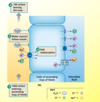ECF Volume Regulation Flashcards
What are the major ECF and ICF osmoles?
ECF - Na+ and Cl-
ICF - Potassium salts
What determines the regulation of ECF volume
Regulation of ECF volume linked to regulation of body sodium
What is the division of total blody water?
2/3rds are found in intracellular fluid
1/3rd is extracellular
ECF is divided into interstitial fluid (majority) and plasma
What components of the body are involved in regulation of sodium?
Dependant on high and low pressure baroreceptors
What are the causes of reduced salt and H2O loss?
Vomitting
Diarrhoea
Excess sweating
(decrease in plasma volume, decrease in venous pressure, decrease in venous return, decrease in atrial pressure, decrease in end diastolic volume, decrease in stroke volume, decrase in cardiac output, decreases in carotid sinus baroreceptor inhibition of sympathetic discharge).
What is the effect of increased sympathetic discharge?
Increase in vasoconstriciton - increase in total peripheral resistance, increase in blood pressure - towards normal

What is the effect of increase in sympathetic discharge on the kidney?
Increase in renal vasoconstriction (renal arteriolar constriction increases) - increase in renin production
Renin leads to formation of angiotensin 2 - this decreases peritubular capillary hydrostatic pressure (increases oncotic pressure) - this causes sodium reabsorption from the proximal tubule - less sodium is excreted
Angiotension 2 causes an increase in aldosterone - increase in distal tubule sodium reabsorption - less sodium excreted
How does the reabsorption range change in times of volume excess compared to times of volume defecit?
Volume excess: reabsorption range is 65%
Volume defecit: reabsorption range is 75% (oncotic pressure is higher in the peritubular capillaries)
How does GFR change when volume changes?
GFR remains relatively unchanged - this is because of renal arteriolar constriction
Sympathetic vasoconstriction of afferent
Angiotensin 2 constricts the efferent

Where does aldosterone regulate sodium reabsorption?
Distal tubule
What are juxtaglomerular cells?
Specialized portion of the smooth muscle in the media of the afferent arteriole - contains large epithelial cells with plentiful granules
What are the juxtaglomerular cells associated with?
The macula densa (a specialised loop of the distal tubule)

Where is renin produced?
In the juxtaglomerular cells
What is renin?
A hormone
Proteolytic enzyme
Acts on angiotensinogen to produce angiotensin 1
Where is ACE found?
Vascular endothelium
The greatest conversion happens when the blood passes through the pulmonary circuit
Angiotensin 1 + ACE = Angiotensin 2
How does angiotensin 2 result in aldosterone release?
Angiotensin II stimulates the aldosterone- secreting cells in the zona glomerulosa of the adrenal cortex.
What is the rate limiting step in the RAAS pathway?
The rate limiting-step is the release of renin since angiotensinogen is always present in plasma.
What controls the release of renin?
1. Pressure in afferent arteriole at the level of the JG cells falls
JG cells act as “renal baroreceptors”
- Sympathetic nerve activity causes increase renin release via b1 effect
- Rate of renin secretion is inversely proportional to rate of delivery of NaCl at the macula densa (specialized distal tubule - essentially a chemoreceptor) decrease in NaCl delivery = Increase in renin
- Angiotensin II feeds back to inhibit renin.
- ADH inhibits renin release (osmolarity control).
Angiotensin 2 and ADH provide feedback
What is the effect of angiotensin 2?
- It stimulates aldosterone and \ NaCl and H2O retention.
- It is a very potent biological vasoconstrictor, 4-8 x more potent than norepinephrine, \ contributes to TPR
- It acts on the hypothalamus to stimulate ADH secretion and increase in H2O reabsorption from CD.
- It stimulates the thirst mechanism and the salt appetite (in the hypothalamus).
What role does the macula densa have in decreasing GFR when the GFR is raised?
Flow through the tubule is increased
Flow past the macula densa increases
Paracrine from macula densa to afferent arterioles
Afferent arteriole constricts
Resistance in afferent arteriole increases
Hydrostatic pressure in glomerulus decreases
GFR decreases
When a person has lost lots of water and salt (as a result of severe diarrhoea) how does the body respond?
ADH serves to increase water reabsorption (however this will effectively lower the already low blood osmolarity) but this is seen as beneficial regardless - normally osmolarity is the main determinant of ADH
Issues in volume take priority over issues in osmolarity - this is because there can be issues in brain perfusion if there is a loss in volume
When does ADH increase?
ECF osmolarity increase
ECF volume decrease
What is the solution to losses of salt and water?
Infuse or drink saline.
What is the effect of ANP on sodium excretion?
ANP promotes sodium excretion









